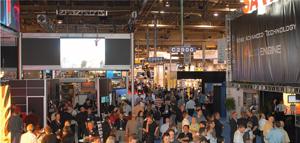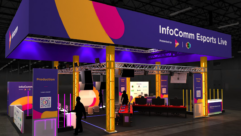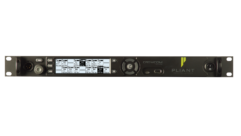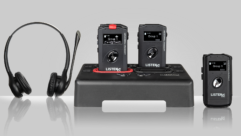

InfoComm 08: Turn Out the Lights
At press time, InfoComm figured more than 34,600 people from 93 countries attended Info-Comm 08, which was more than the organization’s pre-show estimates and nearly 10 percent more than last year?a sign, many say, that the industry remains strong, at least for now, during trying economic times.
ADDING VALUEINTERNATIONAL REACH
COUNTRY SINGER DWIGHT YOAKAM was there (Extron bash), so were the Gin Blossoms (NSCA ExpoJam!), and so were, based on post-show estimates, almost everyone in professional AV. According to InfoComm International, last month’s trade show in Las Vegas was—perhaps not surprisingly considering its merger with NSCA Expo—the largest one ever. And everything from AV-IT integration to new market opportunities was on the table.
At press time, InfoComm figured more than 34,600 people from 93 countries attended Info-Comm 08, which was more than the organization’s pre-show estimates and nearly 10 percent more than last year—a sign, many say, that the industry remains strong, at least for now, during trying economic times. Other facts and figures: There were 988 exhibitors (a new record), 500,000 square feet of exhibition space (up from 465,000 in 2007), and 8,606 registrants for InfoComm Academy courses.
During questioning at the show’s opening Manufacturers’ Forum, it was asked why more attendees didn’t take advantage of the event’s educational opportunities. And while some sessions were certainly better attended than others—InfoComm cited green AV, technology trends, and projection management as particularly popular—InfoComm executive director Randy Lemke was quick to point out that overall registration for on-site classes was up anywhere from 10 to 12 percent.
While manufacturers introduced thousands of products for the very first time, education may ultimately prove more important going forward as vendors and integrators talk more in terms of AV solutions rather than technologies (Editor’s note: PRO AV offers several ways to catch up on new product releases from InfoComm, starting with the New Product sections in our June and July 2008 issues, as well as special InfoComm News Flashes, which you can find in the Newsletter Archive at www.proavmagazine.com). During the Manufacturers’ Forum, Gerry Remers, president of Christie Digital Systems, said “We’re moving away from a focus on technology to a focus on creativity. Creative groups … define solutions and technology is there really to meet their needs.”
Nowhere is that more evident than in the burgeoning digital signage market, where some experts say annual growth is currently at about 35 percent. Jeff Porter, executive vice president of signage solution provider Scala, called it “an opportunity to say, ‘how can I expand my business to do more than hanging screens and running wires?’ It’s an application presence that allows you to move up the food chain and provide additional value-add services.”
The shift from products to creative solutions is subtle. It’s a shift the IT industry has been going through for several years and one that AV integrators understand well—mixing and matching discrete products to address a client’s requirements. The unique challenge many AV pros see is that this mixing and matching must take into account the much-discussed convergence of AV and IT technology.
Anecdotally, most InfoComm attendees felt confident that AV professionals were gaining the required IT skills to succeed in an integrated industry (Crestron president George Feldstein went so far as to say, “The pendulum has swung back to the AV guys.”), but technological challenges remain to ensuring AV runs reliably over IT.
According to Michael MacDonald, executive vice president of Harman Pro Group, those challenges fall into three categories. “First, it’s gotta be standards-based Ethernet. It can’t be a home brew. And it’s gotta be a standard feature on every piece of gear we make,” he told InfoComm attendees. “When it’s optional, the economics fall apart. Costs go up and very few people use it. And we need a common transport protocol. Until we get that, it’s going to be difficult. There’s a lot of rumbling and I think we’re close.”
Another theme resounding at InfoComm was actually the opposite of close, namely the far-reaching growth of AV systems overseas. Through its partnership with the Custom Electronic Design and Installation Association (CEDIA), InfoComm in recent years has watched the Integrated Systems Europe trade show in Amsterdam grow dramatically (see March 2008, page 14), as well as the launch of ISE Russia in 2007.
Last month at InfoComm 08, Integrated Systems Events, the joint-venture of InfoComm and CEDIA, announced Integrated Systems Middle East Africa. This new show will take place March 23–24, 2009, at the Abu Dhabi Exhibition Center in the United Arab Emirates. (InfoComm also operates InfoComm Asia, InfoComm China, and InfoComm India under its own umbrella.)
InfoComm 08: Turn Out the Lights
At press time, InfoComm figured more than 34,600 people from 93 countries attended Info-Comm 08, which was more than the organization’s pre-show estimates and nearly 10 percent more than last year?a sign, many say, that the industry remains strong, at least for now, during trying economic times.
“There is a huge appetite in the Middle East and Africa region for these technologies, and professionals are crying out for a fully focused event,” said Chris Fountain, group director of CMPi UAE, the organization that will help put on the show.
In Las Vegas, InfoComm also previewed its 2008 Asia-Pacific AV Market Definition and Strategy Study. The report found that the professional audiovisual market in the Asia-Pacific region was expected to grow to nearly $18 billion by 2010, up from $13.4 billion last year. According to InfoComm, sales of AV products made up 80 percent of the 2007 figure, while pro AV services accounted for 20 percent. Researchers said they expected the health care and education sectors to grow fastest in Asia, at rates of 19 percent and 17 percent, respectively.
Integrators are already plotting how or even whether to operate in a market that’s increasingly international, based on solutions that utilize IP to link clients’ offices around the world. The merged AVI-SPL held a press conference at InfoComm 08 that underscored the company’s newfound global reach. Meanwhile, The Whitlock Group, another large U.S.-based AV integrator, announced its aggressive move into the European market through a partnership with Impact Marcom, a U.K.-based firm (see “5-Minute Interview,” opposite page).
“We’ve been around since 1955, but in the last 10 years we’ve grown from a local integrator to regional to national to international,” Doug Hall, CEO of The Whitlock Group, tells PRO AV. Hall expects his company’s new alliance, as well as changes throughout the AV industry, to open doors to new opportunities. “In some ways there’s business we haven’t been able to pursue before. Now we can.”










